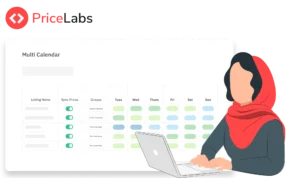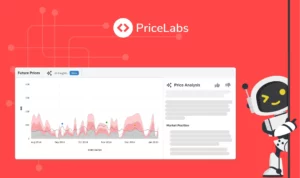Updated: January 18, 2024
January is important for many short-term rental hosts and managers, for instance in North America, Europe, and Japan. Guests start booking spring and summer vacations then. We’ve compiled key checks and updates to help you prepare for the busy season. Consider these now to optimize your property’s revenue performance. These steps will help you refine your pricing strategy. They’ll also help you stay ahead in the competitive rental market. Let’s prepare your listing to make the most of the year ahead!
Summary of the Key Actions to Take:
- Make sure you’re using our Hyper Local Pulse (HLP) algorithm. It provides more accurate, market-specific pricing recommendations. This will help you stay competitive and respond effectively to market shifts. 20,000 users and 110,000 listings already use HLP.
- Review your base price. Check whether we gave a new base price recommendation. It could be that it needs an update due to market changes. Or, maybe you haven’t reviewed it in a while. An accurate base price is crucial for effective dynamic pricing.
- Check Minimum Stay Recommendations. Our Min Stay Recommendation Engine offers tailored suggestions based on market trends. Review these to optimize your booking strategy for different scenarios. These include typical stays, orphan gaps, last-minute, and advance bookings.
- Look at the Events tab. Make sure you know when big events are coming to your market thanks to our Events tab. Our pricing algorithm already takes them into consideration. However, you may want to take extra steps, such as increasing your minimum rates for these dates. Take extra steps such as increasing your minimum rates for these dates.
- Analyze the Future Prices Chart. This tool provides insights into your pricing position. It helps you make informed decisions. It’s based on market trends, past performance, and future predictions.
- Compare Competitors: Track your competitors’ pricing and performance. Understand your market standing and adjust your strategy accordingly.
Here’s how you can do each of these things:
Make sure you’re using our Hyper Local Pulse (HLP) algorithm
The new Hyper Local Pulse (HLP) algorithm offers localized and accurate pricing recommendations. It’s based on your specific market conditions. You can set more competitive prices and respond faster to market changes.
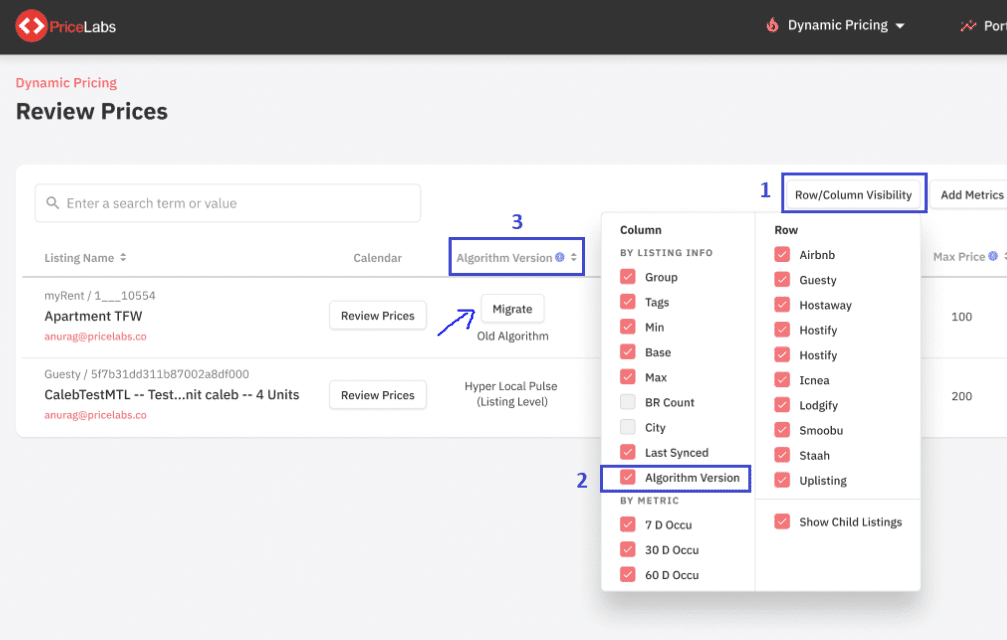

How to Check:
- Check the Algorithm Version in the Pricing Dashboard. Under “Row/column visibility,” check “Algorithm Version.” See if you’re on the “Old Algorithm” or “Hyper Local Pulse.”
- Migrate to the New Algorithm. If you’re using the old one, click “Migrate” and enable “Switch to New Algorithm.” Then, select “New Algorithm (Hyper Local Pulse).”
- Adjust and Save:
- Adjust the recommended base price as needed.
- Update suggested settings and refresh the graph after each change.
- To finalize, either accept the new base price and save changes. Or choose not to save the base price change and then save other changes.
For more details, refer to this migration guide.
Review your base price
You might need to adjust your base price. Changes in market supply, shifts in demand patterns, or a long time since your last change could all be reasons to adjust it. An accurate base price is essential as it’s the foundation for your dynamic pricing.
What to Do:
- Look out for Base Price Nudges:
- These nudges appear on your Pricing Dashboard. They only appear for listings whose base price is more than 5% off from the rate that PriceLabs recommends.
- They help ensure your pricing stays competitive and aligned with market trends.
- You can adjust your price based on these recommendations. Or, you can keep your current pricing.
- Find out more in this article.


- Alternatively, use the Base Price Help tool:
- You can find it on the “Review Prices” page of your Pricing Dashboard or by clicking “More Actions” in the Multi Calendar.
- Setting your Base Price:
- “Recommended Base Price” is given for listings with 13 or more days of data in PriceLabs. It is based on market trends and historical performance.
- “Market-Based Base Price”: Adjust the base price based on market levels, such as Economy, Midscale, and Upscale. Also, align the bedroom categories with your competition.
- Custom Base Price: Input your preferred base price.
- Find out more in this article.
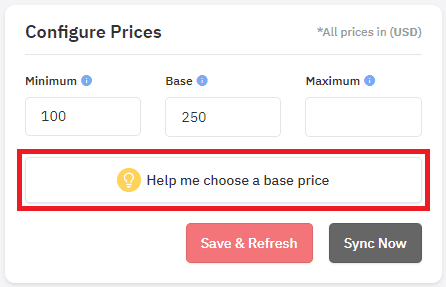

Check Minimum Stay Recommendations
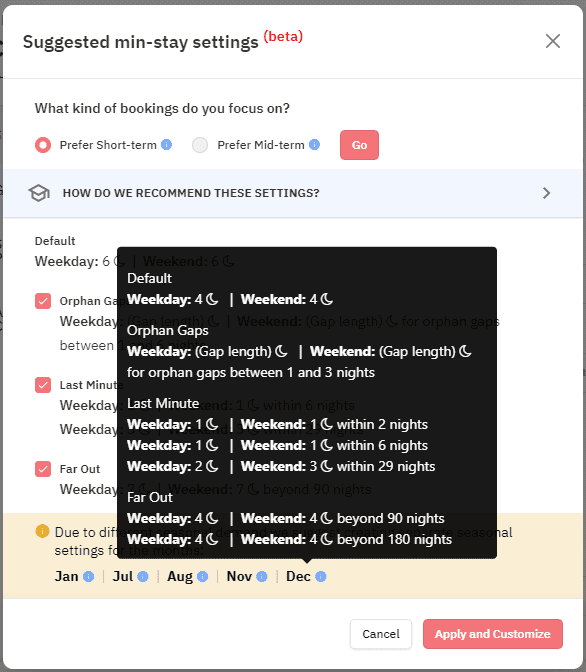

Our Min Stay Recommendation Engine provides customized minimum stay suggestions for your listing. It bases its suggestions on current market trends and tailors them to your property.
- Access: Go to the Customizations tab on the Review Price page for any listing
- The tool displays the following recommendations:
- Default Settings: Offers general minimum stay guidelines for typical weekdays and weekends.
- Orphan Gap Settings tailors minimum stay requirements for short unbooked periods between other reservations. It offers flexibility for different weekday and weekend gaps.
- Last Minute Settings shows minimum stays for bookings made close to the check-in date. This helps to fill vacant nights quickly.
- Far Out Settings shows minimum stays for bookings made well in advance. They aim to secure longer stays during peak demand times.
- Find out more in this article.
Look at the Events tab
Do not miss out on our high-value bookings for a specific bank holiday or if a big concert hits your market. We know it is hard to keep up with some holiday dates changing from one year to another. It’s also challenging to keep track of one-off large events you may have never heard of.
First, the good news is that PriceLabs’s pricing algorithm automatically detects changes in booking patterns. It updates your prices accordingly. Even if you do not know that an event is coming.
Second, check the Events & Holidays tab. It lists upcoming events in your market there. On the “Review Prices” page, on the right-hand side of the pricing calendar, you can find this tab for each listing.
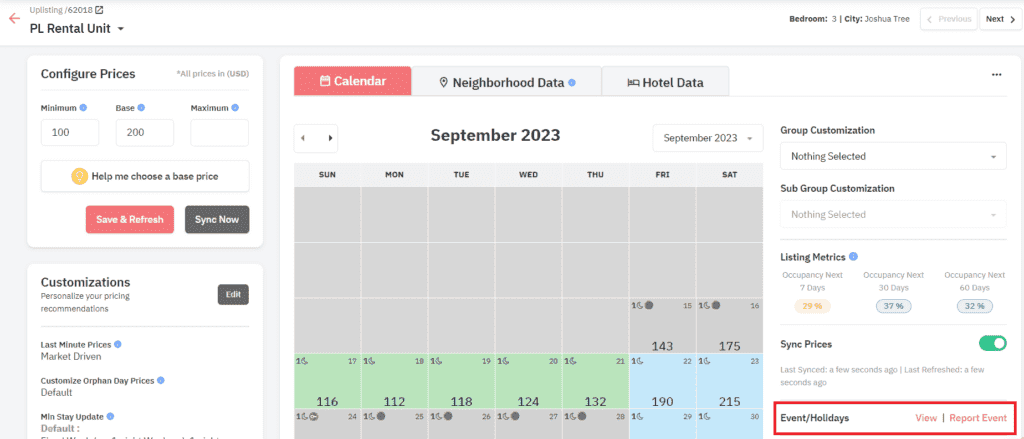

Actions to take:
- Discover in the tab the list of Events, Holidays, and High-Demand dates that we already know about.
- If we’ve missed out on something big, you use this tab to send us a message to let us know.
- If you want to, you can take some measures to make sure you have good value bookings. For instance, you can increase your minimum rate for some specific dates. Go to the calendar, select these dates, and override your default minimum rate with a higher rate. You could also increase the length of stay for these specific dates. Again, you go to your pricing calendar, select these dates, and change the minimum length of stay.
Find out more in this article.
Analyze the Future Prices Chart
The Future Prices Chart helps you make sure you are on track with how the market is moving. It shows when to adjust your prices based on market trends. It also considers past performance and future predictions. It’s like having a roadmap for your pricing strategy. It guides you to better decisions for your rental business.
This chart is located in the Neighborhood Data tab of each of your listings.


- Understand Your Pricing Position. This chart compares your current and past prices with what others in your area are charging. It shows if your rates are higher or lower than others, helping you decide when to raise or lower them. For example, if most local properties charge more in the summer, you might raise your rates, too.
- Track Pricing Changes: The chart tracks how your prices have changed over time. This is crucial for understanding market trends. If you notice your prices are consistently lower than others, it might be time to adjust them to earn more.
- Learn from past bookings. By adding booking data, you can see your average daily rate for upcoming and last year’s bookings. This comparison lets you spot trends. For example, if you’re usually busier during certain months, you can adjust your future prices accordingly.
- Find out more in this article.
Compare Competitors
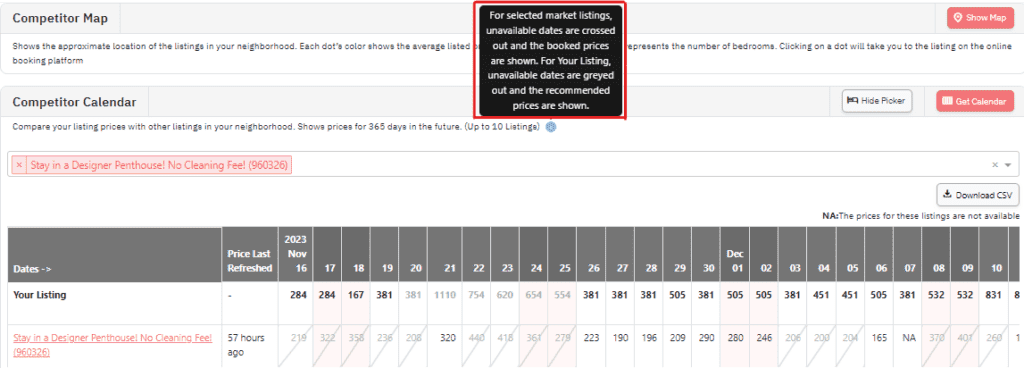

By tracking specific competitors, you can see how your pricing and performance rank against them. This gives you a clearer picture of where you stand in the market.
You can access the Competitor Calendar under the Neighborhood Data tab. It allows you to compare your prices and availability with up to 10 other local listings of your choice. This tool helps you understand how your prices compare to your competitors.
Results:
- There are two ways to view the data in the Competitor Calendar: a Table view and a Graph view.
- The Graph view shows pricing trends. This can help you analyze trends and adjust your prices to stay competitive. For example, if your prices are often lower than other similar listings but your occupancy is high, you might be able to increase your prices.
- Find out more in this article.
As we begin the new year, it’s vital for hosts to stay proactive. These essential January checks are your roadmap to a successful and profitable year. They are essential in the competitive short-term rental market. Let’s make this year your most successful one yet!





